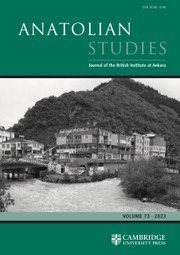No CrossRef data available.
Article contents
Sarruma and his skirt of many patterns: Notes on the signs SARMA1–3
Published online by Cambridge University Press: 28 August 2025
Abstract
The Anatolian hieroglyphs SARMA and its variants were employed during the Late Bronze and Iron Ages to invoke the god Sarruma and as theophoric elements pointing to the same god in personal names. In this paper, these SARMA signs are analysed in order to understand the chronological development of the signs, to challenge the use of ligatures, phonetic indicators and phonetic complements with the sign, to determine the precise semantic value of the sign and whether a phonetic value can be confidently identified or dismissed, and finally to investigate how scribes creatively engaged with the sign in various usages and how readers interacted with the sign and its component elements. It will be argued that an increasingly complex phonetic conceptualisation of the sign grew alongside its semantic value, and that Iron Age scribes creatively juxtaposed signs and other graphic elements to evoke memories of the Hittite past and divine legitimation.
Özet
Anadolu hiyerogliflerinde yer alan SARMA işareti ve varyantları, Geç Tunç Çağı ve Demir Çağı boyunca tanrı Sarruma’yı çağırmak amacıyla ve aynı tanrıya işaret eden teoforik öğeler olarak şahıs adlarında kullanılmıştır. Bu makalede söz konusu SARMA işaretleri, işaretlerin kronolojik gelişimini anlamak; ligatürler, fonetik göstergeler ve fonetik tamam- layıcıların bu işaretle birlikte kullanımına eleştirel bir bakış sunmak; işaretin kesin anlamsal değerini ve güvenilir bir fonetik değerinin belirlenip belirlenemeyeceğini değerlendirmek; son olarak da yazıcıların bu işareti çeşitli kullanımlarda ne şekilde yaratıcı biçimlerde işlediklerini ve okuyucuların işaretle ve onun bileşenleriyle nasıl etkileşime geçtiğini araştırmak amacıyla incelenmektedir. Çalışmada, işaretin anlamsal değeriyle birlikte giderek daha karmaşık bir fonetik kavramsallaştırmaya evrildiği; ayrıca Demir Çağı yazıcılarının, Hitit geçmişine ve ilahi meşruiyete gönderme yapmak amacıyla işaretleri ve diğer grafik unsurları yaratıcı biçimlerde bir araya getirdikleri savunulacaktır.1
Information
- Type
- Research Article
- Information
- Creative Commons
- This is an Open Access article, distributed under the terms of the Creative Commons Attribution licence (http://creativecommons.org/licenses/by/4.0), which permits unrestricted re- use, distribution and reproduction, provided the original article is properly cited.
- Copyright
- © The Author(s), 2025. Published by Cambridge University Press on behalf of British Institute at Ankara

